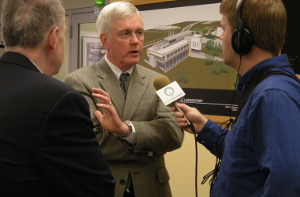Student tackles nitrates with floating islands

In the spring of 2017, Bella brought the question to Nadine Weirather, her science teacher at Central Lee Middle School in Donnellson. Weirather encouraged her to find background material about the problems of nitrate pollution and possible solutions.
Much of the research about cancer and birth defects related to nitrate exposure from drinking water has been conducted in Iowa, according to the University of Iowa Center for Health Effects and Environmental Contamination. Nitrates in water also flow into the Mississippi River from states that border it – including Iowa – and contribute to the low oxygen levels in the Gulf of Mexico, the EPA reported in 2012.
Bella investigated the impact of nitrates on humans and the environment, and considered how to remove nitrates in ponds. You Tube videos and other research gave her the idea to use floating islands of water plants to filter nitrates. But, before she created these islands, she needed to test their impact in a smaller, controlled environment.
Weirather suggested Bella contact the State Hygienic Laboratory and apply for its Student Mentorship Program, which would allow her to team up with a lab scientist to help her test her theories. Her application was approved, and Jessica Owens, an environmental lab analyst, became her mentor.
The controlled environment was found in the Steffensmeier family’s heated garage where Bella assembled four 30-gallon tubs representing her ponds in two side-by-side experiments. Brent Koller, the Central Lee High School Earth Science and Agriculture Science teacher, advised her on how to mimic the impact of fertilizers in the environment. Bella used nitrogen-fixing plants, including two varieties of sedge grass, day lilies and butterfly plants to create little floating islands in the tub water to simulate the larger islands of plants that could be used in a farm pond.
Bella took samples of the nitrate levels in the tubs before introducing the plants in two tubs and then continued monitoring the water with test strips and collecting samples at intervals of 14 days, 30 days and 45 days. Owens worked with Bella in the laboratory to show her how the samples were processed.
It was a learning experience for Bella, and a fulfilling one for Owens. “This is the first time I've helped a student with a project,” Owens said. “It is rewarding to help a young woman interested in science.”
Bella will bring samples to the Hygienic Laboratory for testing as she continues monitoring the experiment. She plans to enter science fairs to demonstrate the outcomes and encourage others to consider the possibilities of this work.
Other Hygienic Lab scientists who advised Bella are Nancy Hall, Environmental Microbiology manager; Evan Kerr, environmental lab analyst; Karen Owens, environmental lab specialist; and Stephen Treimer, environmental laboratory scientist.



